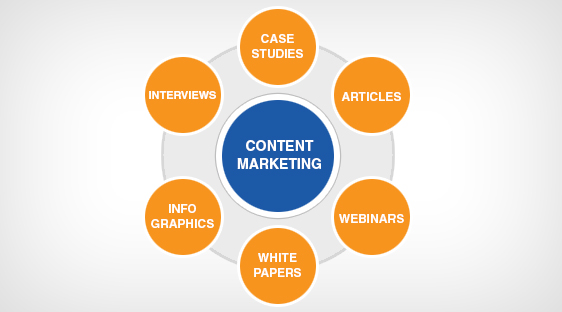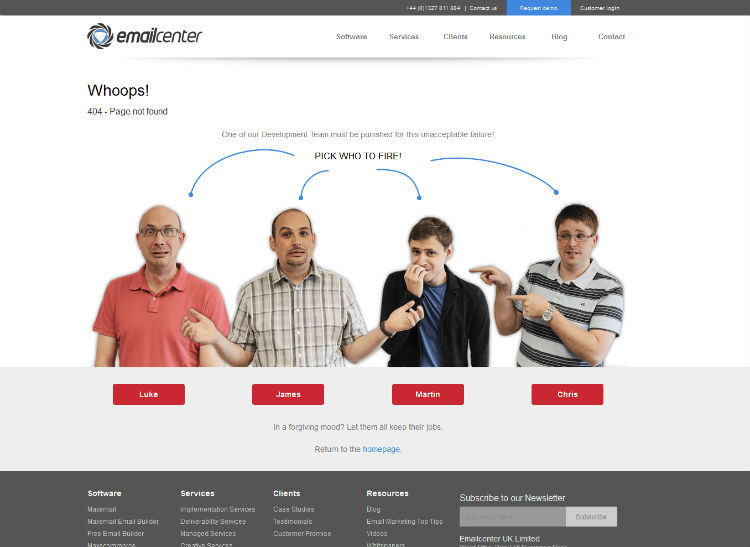The same story about the importance of content marketing has been going on repeat. People did listen, and people did start to pay more attention to it. However, some people aren’t as invested in content marketing as they should be. They’ve heard that it is important, they wrote something here and there, and they think it’s enough. Such people and such an attitude is the reason why we have so much bad and mediocre content online. Don’t be like those people.

Writing truly effective content that makes people pull out their wallets needs to step outside the box. Dare to be different and think beyond the typical content marketing methods.
Originality is becoming a rare quality, which is why consumers reward it. Do you know why originality is rare and why people prefer those companies? Because originality takes time. It’s the easiest thing in the world to simply copy and modify someone else’s content ideas. Being original is challenging and time-consuming, but it’s well worth it once that conversion rate starts to rise.
So, are you ready to give unconventional a try? If you are, the following tips are at your service. These ways of writing unconventional content can give you a fresh approach to creating content that converts.
1. Be Funny and Different
One of the best ways to make your content stand out is with some original humor. Let people have a laugh or two, and you’ll win them over. Laughter is a positive emotion, and positive emotions are proven to influence people’s purchasing decisions more than rational observations.

Get to know your audience (their demographics, likes, and interests), browse their comments to get acquainted with their taste in humor, and you’ll be ready to set sails in humorous waters.
Take a brand like Dollar Shave Club as an example. They’ve built their brand’s marketing on humor, and they’re killing it. Moreover, they matched their content with their target audience – men. There’s no wonder that a daring video titled “Our Blades Are F**king Great” quickly got viral. The video has that cool, funny, “I don’t care” feel, which is why it acted like a magnet for their target audience. Just consider that the video reached nearly 5 million views within the first 90 days.
Dollar Shave Club isn’t the only brand that rocks the original humor concept. There are also Chubbies Shorts, Old Spice, and of course, Snickers, to name a few.
The beauty of humor is that you can use it in all content forms. From blogs to product descriptions. Take a look at some of the product titles by Chubbies:
- The couch captains
- The Saturday mornings
- The domingos are for flamingos
- The loveralls
Chubbies has spread their light humor all around, which is why their content is so likable, and more importantly – selling their products. Humor is the perfect tool for establishing a recognizable brand that can win people over with a single line of content.
2. Use a Copywriting Formula to Boost On-Site Engagement
When you think of copywriting, your mind probably goes to overly salesy content. In reality, great copy doesn’t seem salesy at all. Well-written and strategic copy focuses on consumers and how to provide them solutions to their problems.

You can use copywriting formulas to improve your on-site engagement. When you ensure that your customers are engaged and hooked to your website content, you’ll be on the right track to conversion.
One of the most popular copywriting formulas is the Problem, Agitation, Solution (PAS) formula. PAS formula introduces the problem in the introduction, follows up with agitating the problem, and concludes with a solution.
The PAS formula can be segmented like this:
- Step 1: Help consumers recognize their problems in your content.
- Step 2: Get consumers all fired up about the issues that arise from that problem.
- Step 3: Offer them a solution that can take away those troubles.
To put the PAS formula in action, you need to pinpoint the main problems of your “buyer persona.” Also, you need to surface the worries customers experience because of that problem. After you do that, simply offer them a solution in the form of your product.
Incorporate PAS formula in different content forms. Use it for your landing page, blog posts, new product introductions, and even social media posts. Bear in mind that for the PAS formula to be effective, you need to incorporate these content characteristics:
- Concise
- Direct
- Everyday language
- Readable
3. Educate Users with Interactive Course
“You need to give something to get something,” they say. In this case, you give information and receive sales. Seems like a pretty straightforward deal, right? But there’s more to it.

Educational content is very well received by the audience. You provide them with valuable information, and in return, they provide you with their trust. Creating educational content makes users perceive the brand as credible, trustworthy, and led by experts.
The problem is that typical “text on the screen for miles” educational content can be dull. The solution? Create interactive educational content.
Direct interactive educational content towards your products. Or some aspect of your product that will make people value the product more. For example, if you sell bio-based face creams, you can create an interactive course to educate people about the healthy ingredients for their skin. You can create a game-like concept. Let the users put the offered ingredients in either a face cream or trash bag. They’ll learn about damaging ingredients as well as nourishing ingredients that you use for your products.
After the educational experience, not only will the users be enriched by new pieces of relevant information, but they’ll also grasp how your products are better than others.
Another idea for intertwining the educational content and interactive content is to make an interactive course on how to use your product. This will work well for companies that sell software. It can be somewhat as a tutorial mixed with a trial. Allow users to try out your software in the course but also teach them how to use it. If they like it, there’s no doubt that they’ll buy it.
4. Make Personality Quizzes
People are innately self-oriented. Crafting self-oriented content is a powerful way of attracting people to your brand. Speaking of self-oriented content, how familiar are you with personality quizzes?
Personality quizzes reportedly tell us more about ourselves. While the personality tests should be crafted and executed by psychologists and experts, the internet has brought us personality quizzes. These quizzes help us match our personality with a certain description or character with a similar personality, such as Animal or Dr. Teeth from Muppets.

In Forbes’ article “The Reason Personality Tests Go Viral Will Blow Your Mind,” Jordan Shapiro wrote, “Consumers love personality quizzes. At the time of this writing, Buzzfeed’s “What City Should You Live In” test had already been viewed over 14 Million times in 2 days. Google reports 135,000 monthly queries for “Myers-Briggs” and 301,000 monthly queries for personality tests.”
The truth is out: people like to read about themselves, and personality quizzes make that happen. No matter how trivial they are.
Use this revelation to your advantage. Create personality quizzes that you find to be interesting to your target audience. Try to connect the quiz’s theme to your niche. Let’s say that you sell video games. You can create a quiz “Which Video Game Character Are You?”
Quizzes that are related to your niche can be somewhat as an introduction to your products. Not to mention that you’ll help search engines direct the relevant traffic to your website.
5. Orient Your Content towards Customers
The customer-centric approach is nothing new. It is a well-established fact that customers prefer content that is oriented towards their needs. Add a twist to the customer-centric approach and come up with a different way of putting your customers in focus.
Let us give you an example. You know all about the “employee of the month” ordeal. Take the form of “employee of the month” and start a “customer of the month” campaign. Each month you can pick out the best customer and share some information about them. Base your pick on the number of purchases or amount of purchases. You can even have a “social media edition” and choose “follower of the month” based on the number of comments and likes on your posts.
After you pick out the “customer/follower of the month,” write a short text about them. You can even interview them as an honored customer. How much you’ll publish about the customer (such as whether you’ll include a photo of them or not) should be up to them.
The power of this type of content is that it portrays you as a company that puts customers first. Potential customers will see these posts and think to themselves, “now this is a brand that cares and values their customers.”
Let customers be a part of your content creation process, and you’ll see how the list of customers will grow longer.
6. Be Transparent About Your Brand
Transparency goes hand in hand with honesty. In today’s society, when people are desperate to portray perfection and mask the truth, honesty is more valued than ever.

Speaking openly about your brand, from the people who work there to the production process can be a huge plus. Write content that will help people get to know your brand better.
You can share stories about your employees, including why you hired each one of them. Share how you make your products and why you decided to sell that particular product. Simply put, write as if you are telling your friends all about your business (the good stuff, of course).
Several years ago, McDonald’s shook the world with the “Our Food. Your Questions” campaign. They decided to battle the notorious reputation of their food by openly answering people’s questions about their products. The campaign was focused on transparency as a method of convincing people to trust their company.
In this journey towards transparency, you can publish consumers’ questions and provide answers to them publicly. Mine the questions from social media and your emails. Get customers’ permission to publish the questions on your website. In this way, you’ll give website visitors instant answers to all questions that potential customers like them had.
7. Do Thorough Research on Topics that Interest Your Target Audience
A common mistake among marketers is writing and publishing content that interests primarily them. What they fail to understand is that the content needs to get the audience’s attention, not their own.

Don’t fall into the “you should write about topics that you are passionate about” trap. Sure, writing passionately about the topic is a good bonus, however, your passion shouldn’t be the determining factor. Your target audience’s interests and problems need to be the filters for choosing the right topics.
Deep and thorough research is a good place to start this mission. Browse Quora topics, look into competitors’ comments, Amazon reviews, and posts of favored bloggers of your target audience. Even use marketing tools for determining top searched topics in your niche.
With the plethora of information in your hands, you can pick out the topics that suit your brand and write uniquely about them. For example, if you are a marketing agency, and you consistently come across questions about SEO, write about SEO practice that worked for you. Users won’t be able to find the exact same post anywhere else on the web as you’ll be speaking from your own experience.
Remember that sharing your experience on popular topics among your target audience is a good way of making them original. However, make sure that you truly do have experience in that subject. If you don’t, but you want to write about it, you can always do an experiment. Run a test on that subject and share your findings.
8. Write Content for Magazines and Newspapers
What has happened to good old magazines? They are still out there, and they are still being read, just not as enthusiastically as before.
With the “move of the century” when advertising shifts its main focus from printed magazines to the digital world, most marketers have lost touch with printed issues. Does this mean that they aren’t valuable in terms of marketing? Of course, it doesn’t!

Magazines still have their audience, and you shouldn’t miss out on the opportunity to reach those people as well. Even the local newspapers can do the trick. Whatever you can get your hands on.
Magazines and newspapers can be especially beneficial if your target audience is older people. They are still faithful to printed issues, and that’s your best bet to reach them.
You see, social media is perceived as the number one promotional platform. However, what some tend to forget is that you need to adapt the distribution platform to your target audience, not just do what everyone else does. This is why magazines and newspapers come in handy when your target audience isn’t just Millennials and Gen Z.
9. Make Use Out of 404 Page
You’re probably not aware of how often people run across your website’s 404 page. This page is unfortunately overlooked, even though it has a massive conversion potential.

Instead of allowing users to dwell in their frustration over the 404 page or to ignore it, make the 404 page your friend. Lead those lost customers right to the doors of your high-converting content.
Come up with clever and friendly content for your 404 page. Top that off with an attractive CTA that will lead users to a certain page. There is probably no user in the world who would rather stare at the 404 page instead of going to a new, exciting page.
People’s impatience goes in your favor here. They won’t hesitate for a second to click on the CTA once you offer them a getaway from the boring 404 page.
Don’t miss out on a chance to exploit every page related to your site and turn it into a selling tool. Even if that page is a 404 page.
10. Play Around with Form Field Examples
Form fields are that final step before you get consumers on your side. Whether that’s a form for your subscribers list or registration form, they can put some pressure on the users. Consumers can start questioning whether they really need to “commit” to your brand. It is your job to make those questions go away.
The simplicity and intuitiveness of form fields are the reasons why not many brands think of them as an opportunity for creativity. This can give you an advantage, as it provides you a chance to stand out.
Add examples to form fields but be playful and humorous about it. An example of the “first name” field can be “Darth,” and for “last name,” it can be “Vader.” Get consumers to relax by including funny examples. Use the names of a fictional character, pun pseudonyms, and similar.
When you manage to turn filling in the form into an enjoyable experience, consumers will be more open to the idea of browsing and purchasing your products.
Final Thoughts
Hopefully, these unconventional tips will inspire you to experiment with different content. The secret of conversion is getting people to trust you and feel comfortable with your brand. That’s exactly what these tips are based on. Therefore, don’t wait a minute more. Put these tips to use and observe how your conversion rate is going up.
About the Author
Helene Cue is a writer, editor, proofreader, and experienced content marketing specialist. She has an MBA in marketing, and she expands her knowledge by attending conferences and taking courses. Helene also works as a contributor writer for term paper services and helps students who need someone to write my paper. Her passion is helping businesses create great content and establish an effective strategy to achieve success.


